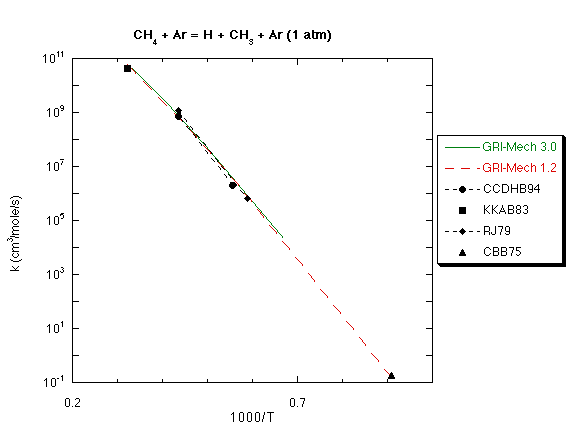k_inf = 1.393E+16 T^(-0.534) exp(-536 cal/mol /RT) cm3/mol s
F_cent = (1-0.783) exp(-T/74) + 0.783 exp(-T/2941) + exp(-6964/T)
Third-body efficiencies:
SOURCE:
For the GRI-Mech 1.1 base mechanism, k_o and F_cent were from Stewart et al. (1989) using <delta E> = 0.30 kcal/mol. A multiplier to the rate coefficient was chosen to be an optimization variable for the optimization of GRI-Mech 1.1. As a result of that optimization, the rate coefficient was increased by a factor of 2.
For the GRI-Mech 1.2 optimization, new RRKM calculations were performed to provide revised values for k_o and F_cent as required to fit the data of Davidson et al. (1995) and as indicated from the results of the GRI-Mech 1.1 optimization. The GRI-Mech 1.2 computations used <delta-E> = 0.40 kcal/mol and an anharmonic treatment of the CH4 density of states. Anharmonicity constants were computed by the Birge-Sponer formula, D=w^2/(4wx). In the GRI-Mech 1.2 optimization, the preexponential factor of k_o was chosen to be an optimization variable, and as a result of optimization its value was increased by 1.4 (i.e., a factor of 1.4 higher than the data of Davidson et al. 1995).
REFERENCES:

PRESSURE = 0.1 atm N2
______________________________________________________________________
Temp delta-S delta-H kf kr Keq
(K) (cal/mol K) (kcal/mol) ----(mol,cm3,s)----- (cm3/mol)
______________________________________________________________________
300 -29.3 -105.1 1.02E+14 3.06E-61 3.32E+74
500 -32.0 -106.1 4.78E+13 4.78E-31 1.00E+44
1000 -34.1 -107.6 4.03E+12 3.69E-09 9.22E+20
1500 -34.3 -107.8 6.01E+11 3.06E-02 1.96E+13
2000 -34.1 -107.3 1.41E+11 4.48E+01 3.15E+09
2500 -33.6 -106.4 4.43E+10 2.44E+03 1.81E+07
3000 -33.2 -105.0 1.70E+10 2.71E+04 6.26E+05
______________________________________________________________________
PRESSURE = 1 atm N2
______________________________________________________________________
Temp delta-S delta-H kf kr Keq
(K) (cal/mol K) (kcal/mol) ----(mol,cm3,s)----- (cm3/mol)
______________________________________________________________________
300 -29.3 -105.1 2.03E+14 6.08E-61 3.32E+74
500 -32.0 -106.1 1.43E+14 1.43E-30 1.00E+44
1000 -34.1 -107.6 2.92E+13 3.14E-08 9.22E+20
1500 -34.3 -107.8 5.19E+12 2.65E-01 1.96E+13
2000 -34.1 -107.3 1.42E+12 4.07E+02 3.15E+09
2500 -33.6 -106.4 4.10E+11 2.26E+04 1.81E+07
3000 -33.2 -105.0 1.58E+11 2.53E+05 6.26E+05
______________________________________________________________________
PRESSURE = 10 atm N2
______________________________________________________________________
Temp delta-S delta-H kf kr Keq
(K) (cal/mol K) (kcal/mol) ----(mol,cm3,s)----- (cm3/mol)
______________________________________________________________________
300 -29.3 -105.1 2.55E+14 7.67E-61 3.32E+74
500 -32.0 -106.1 2.47E+14 2.47E-30 1.00E+44
1000 -34.1 -107.6 9.66E+13 1.05E-07 9.22E+20
1500 -34.3 -107.8 3.15E+13 1.61E+00 1.96E+13
2000 -34.1 -107.3 9.74E+12 3.09E+03 3.15E+09
2500 -33.6 -106.4 3.42E+12 1.89E+05 1.81E+07
3000 -33.2 -105.0 1.39E+12 2.22E+06 6.26E+05
______________________________________________________________________
[ Rate coefficient format | Chemkin file | Thermo data | Main menu ]